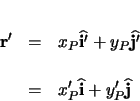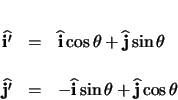



Next: Bibliography
Up: Dynamic Simulation and Analysis
Previous: Clothoids
Contents
Rotation Transformations
Many calculations of a roller coaster track require performing a rotation of a specified angle about a specified axis, as shown in figure B.1. It is desirable to know the location of the points in the rotated frame in terms of the unit vectors describing the non-rotated frame. This appendix will illustrate the calculation performed.
Figure B.1: Rotation Transformations.
This figure illustrates the rotation of the position vector
 through a specified angle
through a specified angle
 .
.

|
Let point  be specified in the
be specified in the  -
- coordinate system by the vector
coordinate system by the vector  .
.
 |
(B.1) |
The  -
- axes are then rotated about the
axes are then rotated about the  axis through an angle
axis through an angle  , resulting in the
, resulting in the  -
- axes. Point
axes. Point  is rotated as well, producing point
is rotated as well, producing point  and position vector
and position vector  , which can be represented two ways.
, which can be represented two ways.
From the figure, it can be seen that:
The new position vector,  , can now be written as:
, can now be written as:
The new coordinates can now be written in terms of the non-rotated axes.




Next: Bibliography
Up: Dynamic Simulation and Analysis
Previous: Clothoids
Contents
Darla Weiss
2000-02-13


![]() be specified in the
be specified in the ![]() -
-![]() coordinate system by the vector
coordinate system by the vector ![]() .
.



